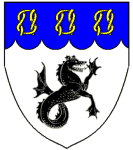| View previous topic :: View next topic |
| Author |
Message |
C-Dawg
Joined: 31 Aug 2007
Posts: 509
City/Region: Spanaway
State or Province: WA
Photos: C-Dawg
|
 Posted: Thu Apr 16, 2009 1:16 pm Post subject: Battery switch and house battery Posted: Thu Apr 16, 2009 1:16 pm Post subject: Battery switch and house battery |
 |
|
I'm getting my ducks in a row to add a house battery. I plan to put a group 24 AGM and a battery charger under the galley. The charger will be powered by the onshore power system to be installed, also.
I read some old threads, but didn't see a couple of things answered.
So, first question: where did others put their battery switch? I'd like to keep it as accessible as possible from either in or out of the boat. Is the splashwell okay with the terminals inside the starboard lazzarette?
But it would also be nice to have it near the battery charger so I can put the charge leads on it; would save running some wire.
Second: anyone have a good schematic of how their boat is wired with dual batteries? Cranking and house batteries, one big motor and kicker.
Thanks.
_________________
Rick & Shirley
Go Dawgs!
C-Dawg sold November 2018 |
|
| Back to top |
|
 |
Sea Wolf
Joined: 01 Nov 2003
Posts: 8650
City/Region: Redding
State or Province: CA
C-Dory Year: 1987
C-Dory Model: 22 Cruiser
Vessel Name: Sea Wolf
Photos: Sea Wolf
|
 Posted: Thu Apr 16, 2009 2:28 pm Post subject: Re: Battery switch and house battery Posted: Thu Apr 16, 2009 2:28 pm Post subject: Re: Battery switch and house battery |
 |
|
| C-Dawg wrote: | I'm getting my ducks in a row to add a house battery. I plan to put a group 24 AGM and a battery charger under the galley. The charger will be powered by the onshore power system to be installed, also.
I read some old threads, but didn't see a couple of things answered.
So, first question: where did others put their battery switch? I'd like to keep it as accessible as possible from either in or out of the boat. Is the splashwell okay with the terminals inside the starboard lazzarette?
My answer: Mine's INSIDE the lazarette completely, accessible from either inside or outside the boat, and completely hidden from view of any vandals or pranksters, and as waterproof as the lazarette door will allow. You can operate the switch from the cockpit, from the dock, or when standing on the ground when the boat's on the trailer. If you can't do the latter, you have to crawl into the boat to turn the power on and off to raise and lower the motor, etc. I'm not sure whether the switch has a waterproof shaft, or not for an inside/outside mount as you describe.
But it would also be nice to have it near the battery charger so I can put the charge leads on it; would save running some wire.
My Comments: You'll want to wire the whole thing with the Off-1-Both-2 switch so that you can use the House battery to start, and the starting battery for the house, if necessary. Run big cables (size depends on starter load and distance to and from switch) from the house battery under the sink to the battery switch in the lazarette. You must install a big fuse or circuit breaker within 7 inches or so of the battery on the positive cable for fire protection. This fuse must be large enough to allow the motor to start, so 100-150 amps should be adequate. Check with your motor manufacturer about the maximum current draw for your starter motor.
The charger leads to the battery should also be fused or protected. Add a fuse or c/b of enough amperage to allow the charger you're getting to work at full capacity. (A fuse here mostly protects against power flowing back into the charger in a malfunction and starting a fire.)
When the power is switched on with your new battery switch, power will flow just as it does now from the back of the boat to the house functions, but now you can choose which battery it comes from. With the switch, you can also turn the switch to BOTH once the House battery is full, and the power from the charger will also charge the starting battery.
Second: anyone have a good schematic of how their boat is wired with dual batteries? Cranking and house batteries, one big motor and kicker.
No, sorry!
Thanks. |
Good Luck!
Joe.  
_________________
Sea Wolf, C-Brat #31
Lake Shasta, California
  
"Most of my money I spent on boats and women. The rest I squandered'. " -Annonymous |
|
| Back to top |
|
 |
NewMoon
Joined: 21 Dec 2008
Posts: 433
City/Region: Holladay
State or Province: UT
C-Dory Year: 1991
C-Dory Model: 22 Cruiser
Vessel Name: Cindy Sea
Photos: Cindy Sea
|
 Posted: Thu Apr 16, 2009 5:51 pm Post subject: Posted: Thu Apr 16, 2009 5:51 pm Post subject: |
 |
|
Hi C-Dawg,
I have a diagram of such a setup. It's a little different, since the diesel engine has a separate alternator and regulator, and there's a Link amp-hour meter, but it should be pretty easy to understand and modify to your needs. It's a Word document, using the simple drawing tools. Post or send your email address and I'll send to you. Mine's newmoon1@prodigy.net
_________________
Richard Cook
Dream Catcher (Nordic Tug 37, 2016 to present)
New Moon (Bounty 257, 1998 to 2016)
Cindy Sea (CD 22 Cruiser, from 1991 to 1998)
"Cruising in a Big Way" |
|
| Back to top |
|
 |
thataway
Joined: 02 Nov 2003
Posts: 21546
City/Region: Pensacola
State or Province: FL
C-Dory Year: 2007
C-Dory Model: 25 Cruiser
Vessel Name: thataway
Photos: Thataway
|
 Posted: Thu Apr 16, 2009 6:15 pm Post subject: Posted: Thu Apr 16, 2009 6:15 pm Post subject: |
 |
|
You want to keep the heavy duty (00) cables to a minumum--and the charging wires will only be 5 to 10 amps, so they can be #10--or even #12 on a C Dory 22. Thus it is better to have both batteries near both the switch and the engine.
You run the 00 cables from the battery to the switch, -the engine start to #1 and house to #2. You put each battery charger positive to the same terminal or to the battery. You put the "output" of the switch to the engine start and circuits of the boat. This way you can use all, 1 or 2. It is best to have a "Make before break" switch--this way the alternator is always connected to a battery and there is no risk of blowing the diodes.
The stove and bilge pump will be directly connected to one of the batteries--and fused appropiately.
For the most part, outboards do not have a fuse between the engine and the battery--all other circuits are fused within 7" as Joe noted.
_________________
Bob Austin
Thataway
Thataway (Ex Seaweed) 2007 25 C Dory May 2018 to Oct. 2021
Thisaway 2006 22' CDory November 2011 to May 2018
Caracal 18 140 Suzuki 2007 to present
Thataway TomCat 255 150 Suzukis June 2006 thru August 2011
C Pelican; 1992, 22 Cruiser, 2002 thru 2006
Frequent Sea; 2003 C D 25, 2007 thru 2009
KA6PKB
Home port: Pensacola FL |
|
| Back to top |
|
 |
Capital Sea
Joined: 16 Dec 2007
Posts: 425
City/Region: Olympia
State or Province: WA
C-Dory Year: 2007
C-Dory Model: 22 Cruiser
Vessel Name: Capital Sea
Photos: Capital Sea
|
 Posted: Thu Apr 16, 2009 7:14 pm Post subject: Posted: Thu Apr 16, 2009 7:14 pm Post subject: |
 |
|
Put the charger under the heater and the house battery under there as well. You should get advice from Aaron at Fife SeaRay if you are going with sealed Gel batteries as he was able to work out the switching, breaker and such, so the system works well with two different size batteries. The switch is such that the only time you will ever want to change its setting is when the crank or house battery is dead. I have never had that situation. The outboards, charge the crank battery first and then the house battery. Also, I had a gage installed on the dash along with an A/B switch, so I can check charge status at the touch of a finger.
There is a thread that shows how to set up shore power with a GFI protected extension cord mounted under the sink and wired into a bulkhead pass through exiting up under the valance to the storage shelf outside the cabin, where it is protected from rain. You plug the charger into the GFI outlet and have another outlet for misc electrical devices while the boat is plugged in. When parked on land, my dehumidifier plugs in here.
Got my kicker servo system in the mail today, so back at ya my friend.
_________________
Capn Steve & 1st Mate Kath
Save our Sound! |
|
| Back to top |
|
 |
thataway
Joined: 02 Nov 2003
Posts: 21546
City/Region: Pensacola
State or Province: FL
C-Dory Year: 2007
C-Dory Model: 25 Cruiser
Vessel Name: thataway
Photos: Thataway
|
 Posted: Fri Apr 17, 2009 4:12 pm Post subject: Posted: Fri Apr 17, 2009 4:12 pm Post subject: |
 |
|
| I suspect that Captain Steve means AGM battery, rather than Gel cell. The charging voltage of the outboard's relitatively poor regulation will damage Gel cells. |
|
| Back to top |
|
 |
Chuck S
Joined: 01 Nov 2003
Posts: 309
City/Region: Cleveland
State or Province: OH
C-Dory Year: 2003
C-Dory Model: 16 Cruiser
Vessel Name: Amelia Anne
Photos: Amelia Anne
|
 Posted: Fri Apr 17, 2009 6:59 pm Post subject: Posted: Fri Apr 17, 2009 6:59 pm Post subject: |
 |
|
Takes very little amperage to start a Honda 50. I don't recall the amps, but I've got one battery on my 16 Criiser and it's a Group 24 deep cycle. Not dual purpose starting/deep cycle. Seems to be handling the small load just fine. I'd think a pair of deep cycles would work just fine with twin 50s.
On my auxillary powered sail boats with two house and starting batteries I just ran the battery charger to the same place on the Off-1-Both-2 switch that the alternator connected. With isolation both batteries would charge off the engine or off the batery charger when idle. Heck, they'd charge with the battery switch in the OFF position without harming the alternator.
-- Chuck |
|
| Back to top |
|
 |
C-Dawg
Joined: 31 Aug 2007
Posts: 509
City/Region: Spanaway
State or Province: WA
Photos: C-Dawg
|
 Posted: Fri Apr 17, 2009 11:21 pm Post subject: Posted: Fri Apr 17, 2009 11:21 pm Post subject: |
 |
|
Since Boater's World is having their going-out-fo-business sale, they have marine wire at 50% off. They have enough 2 AWG for me to do the job; is that big enough to run about 10-12' from house battery to switch?
The next size they had was 1/0 and it seemed way too big for the job. |
|
| Back to top |
|
 |
Capital Sea
Joined: 16 Dec 2007
Posts: 425
City/Region: Olympia
State or Province: WA
C-Dory Year: 2007
C-Dory Model: 22 Cruiser
Vessel Name: Capital Sea
Photos: Capital Sea
|
 Posted: Sat Apr 18, 2009 7:26 pm Post subject: Posted: Sat Apr 18, 2009 7:26 pm Post subject: |
 |
|
| Both Batteries are Optima Bluetop sealed marine multi purpose. |
|
| Back to top |
|
 |
thataway
Joined: 02 Nov 2003
Posts: 21546
City/Region: Pensacola
State or Province: FL
C-Dory Year: 2007
C-Dory Model: 25 Cruiser
Vessel Name: thataway
Photos: Thataway
|
 Posted: Sat Apr 18, 2009 10:46 pm Post subject: Posted: Sat Apr 18, 2009 10:46 pm Post subject: |
 |
|
C Dawg,
You probably can get by with #2. The distance is the total distance or 20 to 24 feet--not 10 feet for calculations. You will get about 6% voltage drop with the #2--to get only 3% drop you could draw no more than 120 amps (not sure what power your outboard draws). |
|
| Back to top |
|
 |
|

 Search
Search Private Messages
Private Messages Profile
Profile Log in
Log in Register
Register Help
Help





